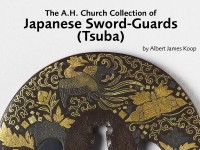The A. H. Church Collection of Japanese Sword-Guards (Tsuba)
An unpublished catalogue of the A. H. Church collection of Japanese sword-guards (tsuba) by Albert James Koop.

One of the greatest craftsmen of his time, Ichinomiya [Japanese text] Nagatsune (1719-1786) belonged to a samurai family of Echizen province (originally of Kaga). As a youth he came to Kiōto and studied under two Gotō masters, but he grew dissatisfied with the rigid canons of their hereditary style and founded a new school of his own. His designs, during his later years, are largely borrowed from the famous Maruyama Ōkio, under whose teaching he became a skilful painter as well as a metalworker. His work illustrates two chief techniques: fine iroye incrustation, and a combination of the katakiri engraving of the Yokoya with the fine inlay of the Kaga workers.
Besides sword-furniture, he did other decorative metalwork with great skill, such as silver brasier ordered by the king of Korea as a gift for the emperor of China, Ch’ien Lung (about 1780). He gained the favour of the Japanese Imperial Court, and Kōkaku (1780-1816) conferred on him the honorary title of Echizen-no-daijō.
His son Nagayoshi and pupils Chōbi and Tsunenao followed in his footsteps with uncertain tread and diminished lustre.
Notice
Object information may not accurately reflect the actual contents of the original publication, since our online objects contain current information held in our collections database. Click on 'buy this publication' to purchase printed versions of our online publications, where available, or contact the Jameel Study Centre to arrange access to books on our collections that are now out of print.
© 2013 University of Oxford - Ashmolean Museum



